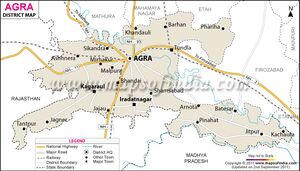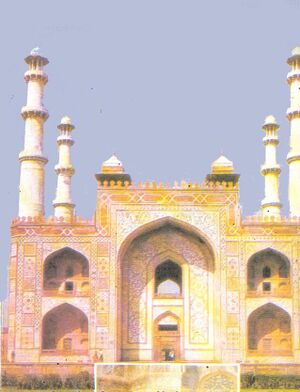Sikandara
| Author:Laxman Burdak, IFS (R) |
Sikandara (सिकंदरा) is a sub of Agra and historical place in Agra district of Uttar Pradesh, India.
Contents
Origin
Sikandara gets name after Sikandar Lodi.
Variants
History
Sikandara is the site of tomb of the Mughal emperor Akbar. This tomb is an important Mughal architectural masterpiece. It was built in 1605–1613 by his son Jahangir and is situated in 119 acres of grounds in Sikandra, a sub of Agra, Uttar Pradesh, India.
On 3 October 1605, Akbar fell ill with an attack of dysentery from which he never recovered. He is believed to have died on 27 October 1605, after which his body was buried at his mausoleum in Sikandra, Agra.[1]
Akbar planned the tomb and selected a suitable site for it. After his death, Akbar's son Jahangir completed the construction in 1605–1613. It cost 1,500,000 rupees to build and took 3 or 4 years to complete.[2]
During the reign of Aurangzeb, Jats rose in rebellion under the leadership of Raja Ram Jat. Mughal prestige suffered a blow when Jats ransacked Akbar's tomb, plundering and looting the gold, jewels, silver and carpets. According to one account, even Akbar's grave was opened and his bones burned.[3][4][5]
As Viceroy of India, George Curzon directed extensive repairs and restoration of Akbar's mausoleum, which were completed in 1905. Curzon discussed restoration of the mausoleum and other historical buildings in Agra in connection with the passage of the Ancient Monuments Preservation Act in 1904, when he described the project as "an offering of reverence to the past and a gift of recovered beauty to the future". This preservation project may have discouraged veneration of the mausoleum by pilgrims and people living nearby.[6]
Battle of Sikandara
Battle of Sikandara was fought between Jats and Mughals in March 1688. During the reign of Aurangzeb, Jats rose in rebellion under the leadership of Raja Ram Jat. Mughal prestige suffered a blow when Jats ransacked Akbar's tomb, plundering and looting the gold, jewels, silver and carpets. According to one account, even Akbar's grave was opened and his bones burned.[7][8][9]
सिकंदरा (आगरा, उत्तर प्रदेश)
सिकंदरा (AS, p.964): उत्तर प्रदेश में आगरा से 6 मील दूर अकबर का समाधि स्थान. इस स्थान का नाम सिकंदर लोदी [p.965] के नाम पर प्रसिद्ध है. अकबर का मकबरा गुंबद रहित है. कहते हैं मुगल सम्राट ने स्वयं ही इसका नक्शा बनवाया था. इसके वास्तु में हिंदू एवं बौद्ध कला शैलियों का मिश्रण है. औरंगजेब के समय में मथुरा-आगरा क्षेत्र के जाटों ने जब राजा राम के नेतृत्व में विद्रोह किया तो उन्होंने अकबर के मकबरे में स्थित उसकी कब्र को खोद डाला और निकाल कर उन्हें जला दिया.[10]
सिकंदरा आगरा परिचय
अकबर का मक़बरा आगरा से 4 किलोमीटर की दूरी पर सिकंदरा में स्थित है। वर्तमान में जहाँ सिकंदरा है, वहाँ सिकन्दर की सेना का पड़ाव था। उसी के नाम पर इस जगह का नाम 'सिकंदरा' पड़ा। सिकंदर के आक्रमण से पहले आगरा एक छोटा सा नगर था। सिकंदरा में मक़बरे का निर्माण कार्य स्वयं अकबर ने शुरू करवाया था, लेकिन इसके पूरा होने से पहले ही अकबर की मृत्यु हो गई। बाद में उनके पुत्र जहाँगीर ने इसे पूरा करवाया। जहाँगीर ने मूल योजना में कई परिवर्तन किए। इस इमारत को देखकर पता चलता है कि, मुग़ल कला कैसे विकसित हुई। मुग़लकला निरंतर विकसित होती रही है। पहले दिल्ली में हुमायूँ का मक़बरा, फिर अकबर का मक़बरा और अंतत: ताजमहल का निर्माण हुआ। मक़बरे के चारों ओर ख़ूबसूरत बगीचा है, जिसके बीच में 'बरादी महल' है, जिसका निर्माण सिकन्दर लोदी ने करवाया था।
अकबर हुमायूँ का बेटा और बाबर का पोता था। वह मुग़ल वंश का और मध्यकालीन भारत के इतिहास का महानतम बादशाह था। उसने 1556 से 1605 ई. तक राज्य किया। उसने एक विशाल साम्राज्य की स्थापना की, जो काबुल से आसाम और कश्मीर से अहमदनगर तक विस्तीर्ण था। उसका राज्य विधर्मी प्रजा के प्रति शान्तिपूर्ण सह-अस्तित्व के ठोस सिद्धान्त पर चलता था, और राजतंत्र मनसबदारी जैसे धर्मनिरपेक्ष संस्थानों पर आधारित था। उसने युद्धरत राजपूत राजाओं को मुग़ल छत्र के नीचे एकत्र किया और देश को एक-सी सांस्कृतिक, राजनीतिक और प्रशासकीय व्यवस्था के अन्तर्गत जोड़ दिया। उसने अपना राजत्व शाखामूल भारतीय भूमि से सम्बद्ध कर दिया और उसे विशुद्ध देशी बना दिया। इसलिए उसे ‘चक्रवर्ती’ का सम्मानसूचक विरुद प्रदान किया गया। उसने भीड़ में से एक राष्ट्र का निर्माण किया। इसी कारण उसे अकबर महान कहा गया।
मक़बरे का निर्माण: सम्राट अकबर एक महान् निर्माता भी था, और उसने अपने सारे साम्राज्य में क़िलों की एक शृंखला बनवाई थी। उसने फ़तेहपुर सीकरी की स्थापना की, जिसमें उसने अपनी छाप की मिश्रित शैली में सुन्दर महल बनवाये। वह वहाँ 13 वर्ष (1572 से 1585 ई. तक) रहा। उसने आगरे के क़िले का पुनर्निर्माण कराया और इसमें अनेकानेक राजकीय इमारतें बनवाईं। उसने अपने मक़बरे की भी स्वयं ही योजना बनाई और उसके लिये सिकन्दरा में यमुना नदी के तट के समीप एक स्थान पसन्द किया। उसका नाम ‘बिहिश्ताबाद’ (स्वर्गिक आवास) हो गया। अकबर की 1605 ई. में मृत्यु हुई। तब मक़बरे का बनना आरम्भ ही हुआ था। इसे उसके बेटे जहाँगीर ने 1612 ई. में अकबर के मूल डिज़ाइन के अनुसार ही पूर्ण कराया।
संदर्भ: भारतकोश-सिकंदरा आगरा
External links
See also
References
- ↑ Majumdar, R. C., ed. (1974). History and Culture of the Indian People. Volume VII: The Mughal Empire. Bombay: Bharatiya Vidya Bhavan.pp.168–169
- ↑ https://archive.org/details/tuzukijahangirio00jahauoft/page/152/mode/1up
- ↑ Edward James Rap;son, Sir Wolseley Haig and Sir Richard, 1937, "The Cambridge History of India", Cambridge University Press, Volume 4, pp.305.
- ↑ Waldemar Hansen, 1986, "The Peacock Throne: The Drama of Mogul India", Page 454.
- ↑ Catherine Blanshard Asher, Catherine Ella Blanshard Asher, 1992, "Architecture of Mughal India - Part 1", Cambridge university Press, Volume 4, Page 108.
- ↑ Rajagopalan, Mrinalini (Summer 2011). "From loot to trophy: the vexed history of architectural heritage in imperial India" (PDF). International Institute for Asian Studies
- ↑ Edward James Rap;son, Sir Wolseley Haig and Sir Richard, 1937, "The Cambridge History of India", Cambridge University Press, Volume 4, pp.305.
- ↑ Waldemar Hansen, 1986, "The Peacock Throne: The Drama of Mogul India", Page 454.
- ↑ Catherine Blanshard Asher, Catherine Ella Blanshard Asher, 1992, "Architecture of Mughal India - Part 1", Cambridge university Press, Volume 4, Page 108.
- ↑ Aitihasik Sthanavali by Vijayendra Kumar Mathur, p. 964-965

